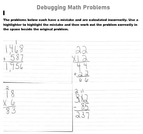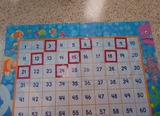
Students locate and correct mistakes (bugs) in standard math algorithms.
- Subject:
- Algorithms and Programming
- Material Type:
- Homework/Assignment
- Author:
- Christopher McElraft
- Date Added:
- 04/18/2022

Students locate and correct mistakes (bugs) in standard math algorithms.

The purpose of this lesson is to help students develop their understanding of algebra using the patterns of multiplcation that occur on a hundreds board. This is an effective strategy that will help students develop an understanding of multiples which is very crucial in 4th grade and above. It also reinforces mutiplication as repeated addition. This is also an effective strategy to use with English Language Learners, Special Educational Students and struggling learners because it provides a hands-on, interactive format for the whole class to see and participate.This lesson is also very engaging and it promotes most of the 5 C's: critical thinking, creative thinking, collaboration, communication, and citizenship.Use the following sites to look at 2 products that I have used from EAI and Didax.https://www.eaieducation.com/Product/504038/Make_a_Splash%e2%84%a2_120_Mat_Floor_Game.aspx (see image)https://www.didax.com/hip-hoppin-hundreds-mat.html

Increasing fluency by using a variety of efficient strategies to solve multiplication facts. Mathematics Instructional Plans (MIPs) help teachers align instruction with the Mathematics Standards of Learning (SOL) by providing examples of how the knowledge, skills and processes found in the SOL and curriculum framework can be presented to students in the classroom.

Building multiplication fact fluency and number sense using arrays and decomposition of factors Mathematics Instructional Plans (MIPs) help teachers align instruction with the Mathematics Standards of Learning (SOL) by providing examples of how the knowledge, skills and processes found in the SOL and curriculum framework can be presented to students in the classroom.